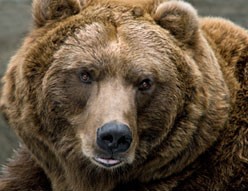The grizzly, one of Alberta’s most iconic animals, is a large bear with a shoulder hump, and ranges in colour from blonde to brown. Males can weigh from 200-300 kg, while female grizzlies weigh 100-200 kg. Grizzlies have a slow reproductive rate, as females typically have their first litter between four and eight years of age, and have long intervals between litters. Grizzly cubs typically remain with their mothers for anywhere from two to five years (Alberta Grizzly Bear Recovery Plan).
As omnivores, grizzlies forage on plant-based sources of foods, such as grasses, berries, roots, but also eat fish, rodents, insects and birds. Grizzlies living closer to human populations may incorporate garbage, livestock and grains into their diet (Alberta Grizzly Bear Recovery Plan).
While most bears will try to avoid humans, when their natural sources of food are in low supply, grizzlies may roam into human-populated areas such as towns or campsites. Once grizzlies learn there is an abundant supply of food in human-populated areas, they may be reluctant to leave (Willis). For strategies and information on how to reduce grizzly/human interaction, visit https://aep.alberta.ca/recreation-public-use/alberta-bear-smart/default.aspx .
The grizzly bear was designated a threatened species in Alberta in 2010, due mostly to human causes such as hunting and self-defence kills (Alberta Grizzly Bear Recovery Plan). Additionally, increased human activity in grizzly territory can result in more human/bear conflicts, which may lead to more bear deaths.
In 2008, the Alberta government introduced the Alberta Grizzly Bear Recovery Plan, a five-year strategy focused on reducing human-caused grizzly deaths, with the goal of achieving a self-sustaining grizzly population. The Recovery Plan included recommendations such as temporarily suspending hunting, controlling use and development of land in grizzly territory and developing education programs (Alberta Grizzly Bear Recovery Plan).
A recent study performed by the University of Alberta has shown that the grizzly population in southwestern Alberta has increased 4% from 2007, a figure that Alberta Environment and Parks believe demonstrates that the Recovery Plan is working (Derworiz). A 2014 study of the area from the boundaries of Banff and Jasper national parks, east to Drayton Valley and Rocky Mountain House, has shown a 7% increase in the grizzly population. Alberta Environment and Parks estimates that the grizzly population could be between 1,000 and 1,200 bears across the province of Alberta, compared to the estimated 700 grizzlies in Alberta prior to the introduction of the Grizzly Recovery Plan (Derworiz). While these numbers are promising, it is clear that more work and conservation efforts are required over the coming years to ensure that Alberta’s grizzly population continues to grow, and eventually, thrive.
Are you interested in learning how you can help AIWC care for injured and orphaned wildlife? Visit https://www.aiwc.ca/support-us/ for more information.
By Anna Wingenbach, AIWC Volunteer
Photo Credit: Alberta Environment and Parks
Sources:
“Alberta Grizzly Bear Recovery Plan.” Alberta Environment and Parks, Web. Mar. 2008. aep.alberta.ca/fish-wildlife/wildlife-management/grizzly-bear-recovery-plan/documents/GrizzlyBear2008-2013-RecoveryPlan-2008.pdf. Accessed 10 Aug. 2017.
Willis, Katie. “How to keep Alberta’s grizzly bears-and yourself-Safe this spring.” University of Alberta, Web. 4 Apr. 2017, www.ualberta.ca/news-and-events/newsarticles/2017/april/how-to-keep-albertas-grizzly-bears-safe. Accessed 10 Aug. 2017.
Derworiz, Colette. “Southern Alberta Grizzly Bear Numbers on the Rise.” Calgary Herald, Web. 29 June 2016, calgaryherald.com/news/local-news/southern-alberta-grizzly-bear-numbers-on-the-rise-survey. Accessed 10 Aug. 2017.






